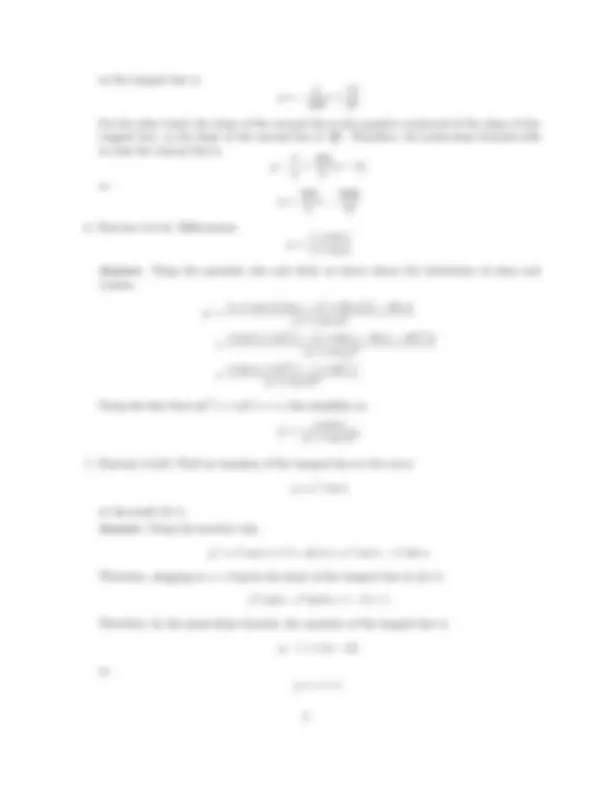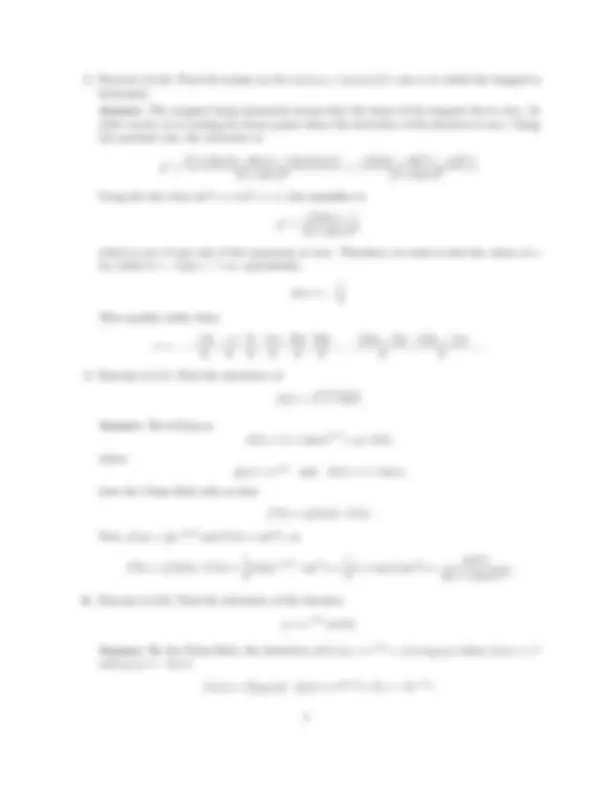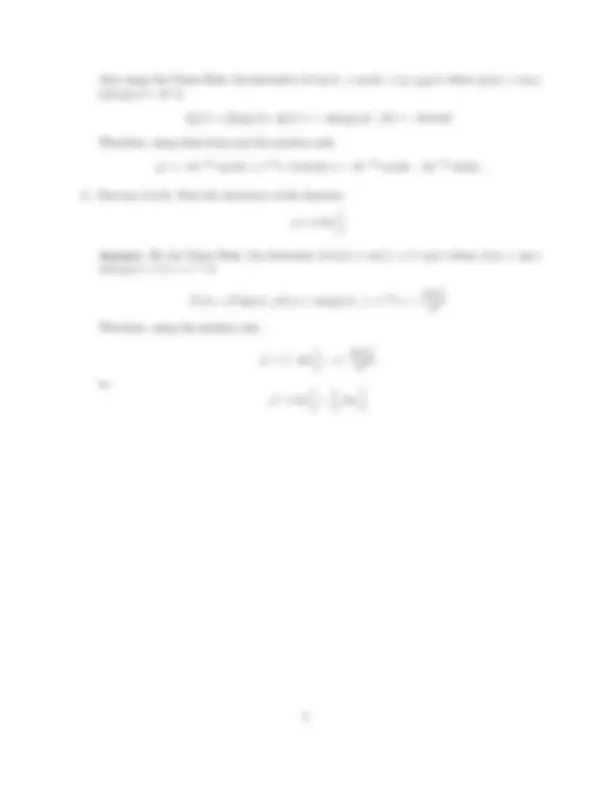





Study with the several resources on Docsity

Earn points by helping other students or get them with a premium plan


Prepare for your exams
Study with the several resources on Docsity

Earn points to download
Earn points by helping other students or get them with a premium plan
Community
Ask the community for help and clear up your study doubts
Discover the best universities in your country according to Docsity users
Free resources
Download our free guides on studying techniques, anxiety management strategies, and thesis advice from Docsity tutors
Find the points on the curve y = (cosx)/(2 + sinx) at which the tangent is horizontal. Answer: The tangent being horizontal means that the slope of the tangent ...
Typology: Study notes
1 / 5

This page cannot be seen from the preview
Don't miss anything!




y =
x(x − 1)
Answer: Re-write the function as
y = x
x −
x = x^3 /^2 − x^1 /^2.
Then, using the power rule,
y′^ =^3 2
x^1 /^2 − 1 2
x−^1 /^2 =^3 2
x − 1 2
x
y = x^4 + 2x^2 − x
at the point (1, 2). Answer: Using the power rule, y′^ = 4x^3 + 4x − 1 , so, at the point (1, 2), y′^ = 4(1)^3 + 4(1) − 1 = 7. Therefore the slope of the tangent line is 7. Since the tangent line passes through the point (1, 2), we can use the point-slope formula:
y − 2 = 7(x − 1),
so, adding 2 to both sides, we have that
y = 7x − 5.
1 − xex x + ex^. Answer: Using the quotient and product rules,
f ′(x) = (x^ +^ e
x)(−ex (^) − xex) − (1 − xex)(1 + ex) (x + ex)^2
= −xe
x (^) − x (^2) ex (^) − e 2 x (^) − xe 2 x (^) − (1 + ex (^) − xex (^) − xe 2 x) (x + ex)^2
=
− 1 − (1 + x^2 + ex)ex (x + ex)^2.
f ′(x) =
2 x
3 / 2
ex^ + x^5 /^2 ex^ =
2 x
3 / (^2) ex (^) + x 5 / (^2) ex. (1)
Taking the derivative of the first term yields 5 2
2 x
1 / (^2) ex (^) + x 3 / (^2) ex
=^154 x^1 /^2 ex^ +^52 x^3 /^2 ex,
whereas the second term in (1) is just a copy of f , so its derivative is the same as f ′(x). Therefore,
f ′′(x) =
4 x
1 / (^2) ex (^) +^5 2 x
3 / (^2) ex
=
4 x
1 / (^2) ex (^) +^5 2 x
3 / (^2) ex
2 x
3 / (^2) ex (^) + x 5 / (^2) ex
4 x
1 / (^2) ex (^) + 5x 3 / (^2) ex (^) + x 5 / (^2) ex.
y =
x x + 1 at the point (4, 0 .4). Answer: Writing
x as x^1 /^2 and using the quotient rule,
y′^ =
(x + 1)
2 x−^1 /^2
− x^1 /^2 (1) (x + 1)^2
=
1 2 x
2 x
− 1 / (^2) − x 1 / 2 (x + 1)^2
=^1 2
x−^1 /^2 − x^1 /^2 (x + 1)^2
=^1 2
√^1 x −
x (x + 1)^2 Therefore, we can plug in x = 4 to get the slope of the tangent line at (4, 0 .4):
1 2
√^1 4 −
1 2 −^2 25
Therefore, we can use the point-slope formula to get the equation of the tangent line:
y − 2 5
(x − 4),
y′^ = (2 + sin^ x)(−^ sin^ x)^ −^ cos^ x(cos^ x) (2 + sin x)^2
= −2 sin^ x^ −^ sin
(^2) x − cos (^2) x (2 + sin x)^2
Using the fact that sin^2 x + cos^2 x = 1, this simplifies to
y′^ = −2 sin^ x^ −^1 (2 + sin x)^2
which is zero if and only if the numerator is zero. Therefore, we want to find the values of x for which 0 = −2 sin x − 1 or, equivalently,
sin x = − 12.
This equality holds when
x =... , −^5 π 6
, −π 6
, 7 π 6
, 11 π 6
, 19 π 6
, 23 π 6
,... , (12n^ −^ 5)π 6
, (12n^ −^ 1)π 6
f (t) = 3
1 + tan t.
Answer: Re-writing as f (t) = (1 + tan t)^1 /^3 = g ◦ h(t), where g(u) = u^1 /^3 and h(t) = 1 + tan t, then the Chain Rule tells us that f ′(t) = g′(h(t)) · h′(t).
Now, g′(u) = 13 u−^2 /^3 and h′(t) = sec^2 t, so
f ′(t) = g′(h(t)) · h′(t) =
3 (h(t))
− 2 / (^3) · sec (^2) t =^1 3 (1 + tan^ t) sec
(^2) t = sec^2 t 3(1 + tan t)^2 /^3
y = e−^5 x^ cos 3x.
Answer: By the Chain Rule, the derivative of h 1 (x) = e−^5 x^ = f 1 circg 1 (x) where f 1 (u) = eu and g 1 (x) = − 5 x is
h′ 1 (x) = f 1 ′(g 1 (x)) · g′ 1 (x) = eg^1 (x)(−5) = − 5 e−^5 x.
Also using the Chain Rule, the derivative of h 2 (x) = cos 3x = f 2 ◦ g 2 (x) where f 2 (u) = cos u and g 2 (x) = 3x is
h′ 2 (x) = f 2 ′(g 2 (x)) · g 2 ′(x) = − sin(g 2 (x)) · (3) = −3 sin 3x.
Therefore, using these facts and the product rule,
y′^ = − 5 e−^5 x^ cos 3x + e−^5 x(−3 sin 3x) = − 5 e−^5 x^ cos 3x − 3 e−^5 x^ sin 3x.
y = x sin^1 x
Answer: By the Chain Rule, the derivative of h(x) = sin (^1) x = f ◦ g(x) where f (u) = sin u and g(x) = 1/x = x−^1 is
h′(x) = f ′(g(x)) · g′(x) = cos(g(x)) · (−x−^2 ) = −
cos (^) x^1 x^2
Therefore, using the product rule,
y′^ = 1 · sin^1 x − x ·
cos (^1) x x^2 , so y′^ = sin
x −^
x cos
x.